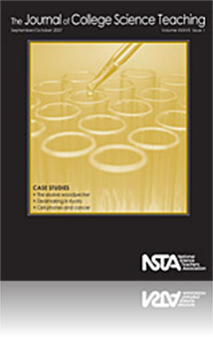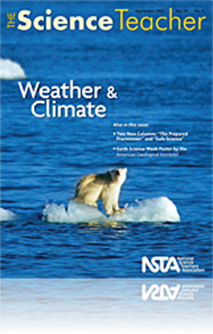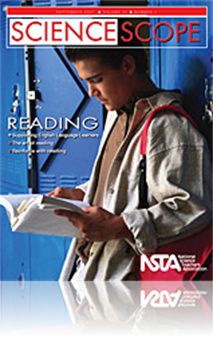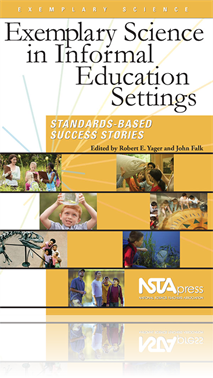All Resources
Journal Article
Giving Birth to Someone Else’s Children? A Case of Disputed Maternity
Most students have heard about situations in which the paternity of a child is questioned; in a surprising reversal, in this case study, maternity is in question. Designed for an introductory biology course, the case involves concepts from genetics, ...
Journal Article
A Cooperative Classroom Investigation of Climate Change
Scientists have a particularly difficult time explaining warming trends in Antarctica—a region with a relatively short history of scientific observation and a highly variable climate (Clarke et al. 2007). Regardless of the mechanism of warming, how...
Journal Article
Editorial: The Boy Scouts Said It Best—Some Advice on Case-Study Teaching and Student Preparation
Students are seldom prepared. They have many things, most not related to school, on their minds in college. In large classes in particular, student attendance falls off precipitously with each passing week of the semester, regardless of the skill of ...
Journal Article
Perspectives: Action Research: Inquiring Into Science Teaching and Learning
Teachers and schools are required by the No Child Left Behind Act to use research-based instructional practices. Although we often think of research as something university professors do, teachers can contribute to the research base on effective inst...
Journal Article
Science Sampler: Metamorphosing into readers
One way to encourage students to read is to choose a subject that interests them. During middle school, students are metamorphosing into young adults. To take advantage of their natural interest in body changes, this unit on moths and butterflies was...
Journal Article
Numerous connections exist between climate science and topics normally covered in physics and physical science courses. For instance, lessons on heat and light can be used to introduce basic climate science, and the study of electric circuits provide...
Journal Article
The hydrologic cycle is a very basic scientific principle. In this article, background information is presented on how the hydrologic cycle provides scientists with clues to understanding the history of Earth’s climate. Also detailed is a web-based...
Journal Article
Supporting English Language Learners’ Reading in the Science Classroom
It may seem obvious that students with limited reading skills also have limited educational opportunities. Students acquiring English as their second, non-native language—presently referred to as English Language Learners (ELLs)—face this obstacl...
Journal Article
Science Sampler: Give students a purpose to read
After some reflection, the author found that by giving her students a purpose to read has led to a deeper understanding of the text. In this article, she outlines the questions teachers should ask themselves prior to assigning a reading to ensure its...
Journal Article
Every Day Science Calendar: September 2007
This monthly feature contains facts and challenges for the science explorer. ...
Journal Article
Many teachers bring caterpillars into their class for their students to see the transformation from caterpillar to butterfly. This is exciting and educational, but more can be done using Monarchs across the curriculum. An integrated butterfly unit ...
Journal Article
Editor’s Corner: Everybody Talks About It
Articles in this issue of The Science Teacher (TST) show how the weather and climate theme offers a rich opportunity for interdisciplinary inquiry in our science classes. An integrated, interdisciplinary investigation of climate may perhaps inspire...
Journal Article
Kids tracking sea turtles? No, it’s not a description for a new nature show on TV, it’s a lesson, and it could be happening in your classroom! Sea turtle biologists worldwide are currently working together to track turtles to learn about sea turt...
Journal Article
Exploring Animals, Glossopedia Style
It’s the first day of the “Animals” unit for Tami Brester’s third-grade class and the first day her students are using Glossopedia, a free online multimedia science encyclopedia. But you wouldn’t know that from observing the kids, who are e...
Journal Article
The Tree of Animal Life activity is a simple, sorting exercise that can help them see a bigger picture. The activity sets the stage for learning about animal taxonomy and introduces the characteristics of various animal groups in a general way. Thoug...
Journal Article
Students can gain an appreciation for the structure and function of local environments by studying the potential impacts of small changes in local microclimate on plant distribution. The concept of microclimate is easy for students to comprehend, sim...
Journal Article
Science Sampler: Using the arts to enhance science learning
Over the years, the author has developed several lessons in which songs, arts and crafts, drama, and body motions are used to better facilitate student learning in life science. This article presents a sample of songs that correspond with a study of ...
Journal Article
Teacher’s Toolkit: Methods for success as a middle school science teacher
Effective teachers are prepared with methods for teaching science. Without them, the first day of school will be a disaster that will likely continue throughout the year. This article outlines some methods that will ensure success in teaching middle ...
Journal Article
Tech Trek: Electronic bulletin boards and digital student groups
Nothing is as irksome as a student who returns from a couple of days of being absent and asks nonchalantly, “Did I miss anything?” Not only do you have to backtrack through what you did in the last few days of instruction, but you must also remem...
Book Chapter
Science with Attitude: An Informal Science Education Experience
Kansas City's Science City Summer Camp is an eight-week program for children of ages 6-12 from a variety of socioeconomic backgrounds. Drawing on the knowledge that people have diverse learning styles, Science City introduces science concepts each da...
Journal Article
Editor's Note: Animals and the Capacity to Care (September 2007)
While the study of animals can serve to motivate, it can also present difficulties. Some animals are just too hard to study through inquiry. The animals may be too large or small, too distant, or too dangerous to bring into the classroom. Technology ...
Journal Article
Teaching through Trade Books: The Dirt on Soil
Have you ever played in the dirt? Repotted a plant? Planted a garden? In each and every one of these activities, you touched something that is a valuable resource in our lives—dirt! This month’s column has students investigating different aspects...
Journal Article
Science Sampler: Did the beanstalk really reach the sky? Using fairy tales to teach science
Inquiry is the guiding philosophy in school science curriculum design in Singapore. Inquiry requires students to be able to use their existing scientific knowledge to formulate hypotheses and critique and evaluate things they observe around them. Thi...
Journal Article
Idea Bank: Thinking Like Scientists
Students often find it challenging to adopt the mindset needed in inquiry-based science classes—that is, to think and act like scientists and use the processes of science. To familiarize students with this mindset, begin the school year with the ac...
NSTA Press Book
NSTA Guide to Planning School Science Facilities, Second Edition
Science-learning spaces are different from general-purpose classrooms. So if your school is planning to build or renovate, you need the fully updated NSTA Guide to Planning School Science Facilities. It’s the definitive resource for every K-12 scho...
By LaMoine L. Motz , James T. Biehle, Sandra S. West
Journal Article
Formative Assessment: Redirecting the Plan
The science teachers at New Hampshire’s Concord High School are no longer satisfied with what Wiggins and McTighe call the “teach, test, and hope for the best” learning cycle (2005). These teachers have been stepping up to the professional resp...







